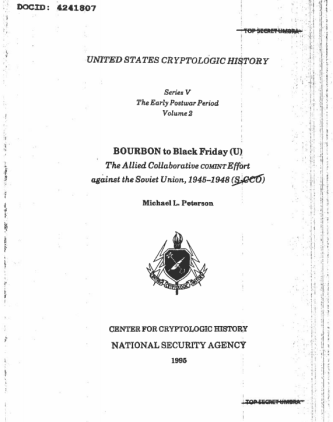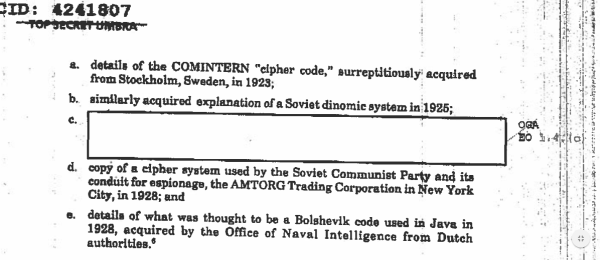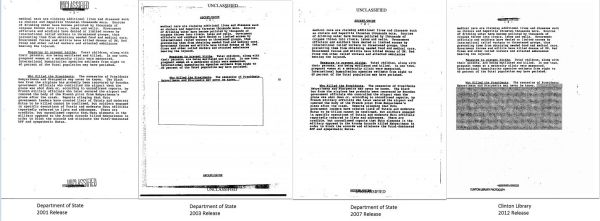90-year-old Cryptanalytic Efforts Must Stay Secret, says NSA
The National Security Agency is withholding 90-year-old information on early American cryptanalytic efforts against Russia and the Soviet Union from a 20-year-old document on the grounds that releasing the information could “reasonably be expected to cause identifiable or describable damage to national security.”
Specifically, the NSA claims that the release of the information would harm another government agency’s (OGA) “intelligence activities (including covert action), intelligence sources or methods, or cryptology” – the OGA cited by the NSA is either the Defense Intelligence Agency (DIA) or the CIA.
 The NSA withheld the passage on 1920s cryptanalytic efforts from “Bourbon to Black Friday: The Allied Collaborative COMINT Effort against the Soviet Union, 1945 – 1948,” an internal NSA history authored by Michael Peterson. The agency, however, released information on:
The NSA withheld the passage on 1920s cryptanalytic efforts from “Bourbon to Black Friday: The Allied Collaborative COMINT Effort against the Soviet Union, 1945 – 1948,” an internal NSA history authored by Michael Peterson. The agency, however, released information on:
- Details of the COMINTERN “cipher code,” surreptitiously acquired from Stockholm , Sweden , in 1923;
- Similarly acquired explanation of a Soviet dinomic system in 1925; and
- Details of what was thought to be a Bolshevik code used in Java in 1928, acquired by the Office of Naval Intelligence from Dutch authorities.
The NSA withholding 90-year-old information adds to a growing list of dubious secrets. Other (by no means exhaustive) examples include:
- The CIA withholding documents from 1917 and 1918 — including a document that described World War 1 “secret ink” recipes and instructions on how to open sealed letters covertly. The CIA kept these documents secret until 2011, and then misleadingly crediting their declassification to “recent advancements in technology.” The real reason these documents saw the light of day, however, was of a decade-long Freedom of Information Act fight, lawsuits, a Mandatory Declassification Review request, and finally, an appeal to the Interagency Security Classification Appeals Panel to pry the documents loose;
- The Defense Department needlessly redacting Nikita Khrushchev’s public statements about Jupiter missiles in Turkey from a 50-year-old document;
- The DIA withholding large sections of a 1975 biographical sketch of General Augusto Pinochet on national security grounds, including Pinochet’s liquor choices – “scotch and pisco sours” – even though it had released the document a year earlier without the redactions;
- Multiple instances of declassification authorities withholding the contents of documents on anti-ballistic missiles, strategic arms control, and U.S. policy toward China, all of which had been declassified years earlier, with one of them even published in the State Department’s historical series, Foreign Relations of the United States;
- Defense Department classification of “Poodle Blanket” contingency plans from 1961 for a possible confrontation over West Berlin; and
- Declassifiers withholding different portions of the same State Department document four times over a 12-year period.
The NSA’s very dubious withholding also supports arguments made by National Security Archive executive director Tom Blanton in a July 2015 Washington Post op-ed, in which he says, “real secrets make up only a fraction of the classified universe, and no secret deserves immortality…I showed Congress the estimates over the years of how much gets classified that doesn’t deserve to be. Ronald Reagan’s executive secretary for the National Security Council, Rodney B. McDaniel, said 90 percent. Thomas H. Kean, the Republican head of the 9/11 Commission, said 75 percent of what he saw that was classified should not have been.”
It’s safe to say NSA declassifiers didn’t get a chance to read Blanton’s op-ed. They should go back and do so.
Many thanks to Dr. Jeffrey Richelson, director of the Archive’s Cyber Vault, for bringing this document to my attention.
Comments are closed.



Ridiculous, but unfortunately not unusual.